Actualización importante: No más prórrogas automáticas del permiso de trabajo para los solicitantes de asilo
Actualización importante: No más prórrogas automáticas del permiso de trabajo para los solicitantes de asilo

If you are an asylum seeker in the United States, you may already know that you are eligible to apply for an Employment Authorization Document (EAD) while your asylum case is pending. These work permits are generally issued for five (5) years. However, asylum cases often involve long processing times and can take years to resolve, so many applicants must renew their EADs to maintain their ability to work. Until recently, if you renewed your EAD before it expired, you automatically received a 540-day (about 18 months) extension while USCIS processed your renewal. This extension helped people avoid losing their jobs due to processing delays.
What Changed?
A new USCIS rule has eliminated this automatic extension for asylum seekers and certain other categories.
Now, if your current EAD expires before USCIS finishes processing your renewal, you will not be allowed to work lawfully until you receive the new card.
USCIS says the change is meant to ensure “full vetting” during each renewal, claiming that automatic extensions could allow individuals to continue working before updated security checks are completed. They highlighted one serious incident as justification, although the connection to the EAD extension process is unclear and has been widely criticized.
Who Is Affected?
This change affects people who are not authorized to work automatically based on their immigration status, including:
- Asylum seekers
- Individuals granted Withholding of Removal
These groups will no longer receive an automatic work permit extension.
However, people who already filed a renewal before October 30, 2025, will still receive the extension.
Also, people who have already been granted asylum or who came to the U.S. as refugees are not affected by this rule.
How Could This Impact You?
- You could lose your job if your EAD expires before the renewal is processed.
- Employers may become even more cautious about hiring asylum applicants.
- The change may also affect healthcare systems and other essential services that rely heavily on immigrant workers.
What Should You Do Now?
Since processing times are unpredictable (currently about 6.5 months on average, and sometimes longer), waiting until 180 days before expiration may not be enough anymore.
USCIS doesn’t let you file more than 6 months before your EAD expires, but since processing times can sometimes be longer than that, it’s a good idea to work with an attorney who can help you plan ahead and avoid gaps in work authorization.
Need Guidance? We’re Here to Help.
If you are unsure when to file, how this change affects your case, or what documents you need:
- Concertar una consulta with one of our attorneys at PPID today. Call us at 212-233-8100.

